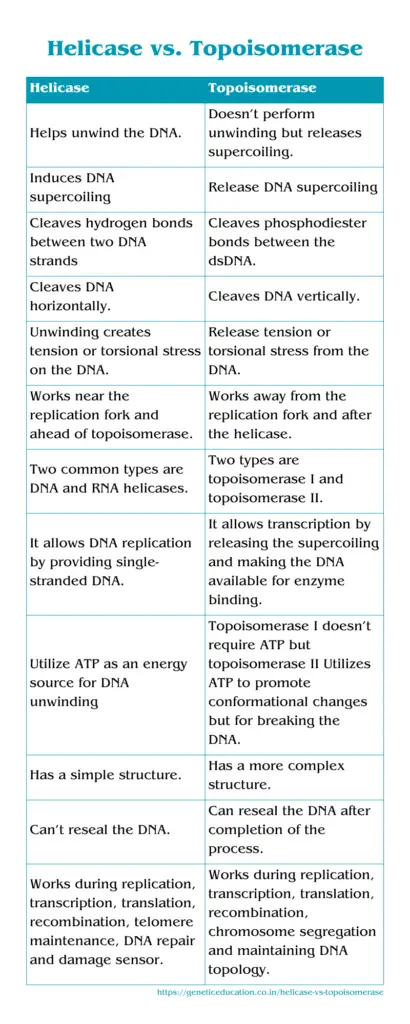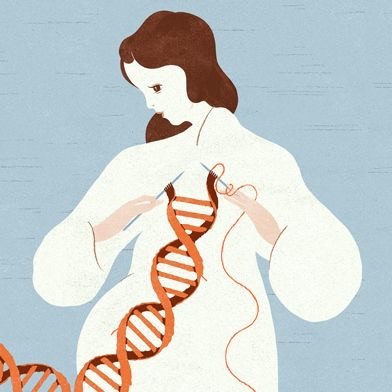“Enzymes Helicase and Topoisomerase work during DNA replication. Helicase unwinds DNA while topoisomerase releases supercoiling. Explore some of the important differences between helicase vs topoisomerase.”
Replication is a process of synthesizing DNA. Meaning, it copies the DNA- a duplex forms another duplex. It’s an enzyme-governed process in which various enzymes participate timely.
Helicase, topoisomerase, primase, various polymerase and ligase timely came into action starting from replication initiation to completion. Enzymes helicase and topoisomerase almost look similar in function.
But let me tell you they are different not only in structure but in function and many other aspects. In this article, we will discuss some of the important differences between helicase and topoisomerase. I will also enlist a few more interesting differences that you will never find in any other articles.
At Genetic Education Inc. we re-discover the knowledge to make it more understandable. Our articles are well-researched, written, and reviewed. The information is collected from peer-reviewed sources. The sources are listed at the end of the article.
Stay tuned.

Differences Between Helicase vs Topoisomerase:
The structure of the helicase is simpler compared to the topoisomerase. Helicase contains a DNA or nucleotide-binding domain and ATP domain, often known as Walker motifs.
Contrary, the complex structure of topoisomerase contains a DNA-binding domain, a separate catalytic domain and ‘gate’ and ‘clamp’ like other motifs.
The pivotal function of DNA helicase is to unwind the DNA. It converts the double-stranded DNA into two single-stranded ones. The main function of the topoisomerase is to release tension from the DNA, which occurs by unwinding.
Meaning, that topoisomerase either cuts a single-stranded or double-stranded DNA and releases the tension or torsional stress on the DNA. Note that higher DNA tension will slow down the replication process.
Helicase-mediated DNA unwinding occurs by hydrolysis of hydrogen bonds between two DNA strands. On the other hand, topoisomerase hydrolyzes the phosphodiester bonds between the adjacent nucleotides of the DNA.
Thus, helicase cleaves DNA horizontally while topoisomerase cleaves DNA vertically. See the image below.

Helicase creates tension on the double-stranded DNA while the topoisomerase releases tension from the DNA.
Two common types of helicases are DNA helicase and RNA helicase. whereas two types of topoisomerases are topoisomerase I and topoisomerase II.
It’s important to discuss that DNA helicase and RNA helicase unwind DNA and RNA, respectively. Shockingly, both topoisomerase I and topoisomerase II release tension for the DNA only.
As aforesaid, topoisomerase I cleaves single-stranded DNA while topoisomerase II cleaves double-stranded DNA to release DNA tension.
Further read: Function of Topoisomerase I and Topoisomerase II.
As we all know and talked about in the previous article, the helicase uses ATP as an energy source to perform the catalytic reaction. Contrary, among the two types of topoisomerase, topoisomerase II uses the ATP but for doing conformational changes in its structure not for catalytic reaction.
Helicase works nearer and a bit ahead of the replication fork and continuously moves forward. While the topoisomerase works away from the replication fork and ahead of the helicase.
(Because its ultimate function is to release tension induced by the helicase).
Technically, helicase induces DNA supercoiling while topoisomerase releases DNA supercoiling.
Helicase allows replication by providing a single-stranded template DNA while topoisomerase not only helps in the replication to release the tension but also allows transcription by releasing the supercoiling.
Highly supercoiled states of DNA (known as heterochromatin) are transcriptionally inactive. Topoisomerase releases the supercoiling and provides DNA for enzymes and transcriptional factors for transcription to occur.
Helicase and topoisomerase both have a significant role in replication, transcription and recombination.
Helicase helps in replication, transcription elongation, recombination, telomere activity, DNA repair, DNA structural integrity and as a DNA damage sensor indicator. While the topoisomerase helps in replication, transcription, recombination and DNA repair.
One crucial difference between helicase and topoisomerase that no one is talking about is the unique and amazing property of the topoisomerase. Helicase doesn’t reseal the unwinding after completion of catalytic action but the topoisomerase reseal DNA after completion of its action.
| Helicase | Topoisomerase |
| Helps unwind the DNA. | Doesn’t perform unwinding but releases supercoiling. |
| Induces DNA supercoiling | Release DNA supercoiling |
| Cleaves hydrogen bonds between two DNA strands | Cleaves phosphodiester bonds between the dsDNA. |
| Cleaves DNA horizontally. | Cleaves DNA vertically. |
| Unwinding creates tension or torsional stress on the DNA. | Release tension or torsional stress from the DNA. |
| Works near the replication fork and ahead of topoisomerase. | Works away from the replication fork and after the helicase. |
| Two common types are DNA and RNA helicases. | Two types are topoisomerase I and topoisomerase II. |
| It allows DNA replication by providing single-stranded DNA. | It allows transcription by releasing the supercoiling and making the DNA available for enzyme binding. |
| Utilize ATP as an energy source for DNA unwinding | Topoisomerase I doesn’t require ATP but topoisomerase II Utilizes ATP to promote conformational changes but for breaking the DNA. |
| Has a simple structure. | Has a more complex structure. |
| Can’t reseal the DNA. | Can reseal the DNA after completion of the process. |
| Works during replication, transcription, translation, recombination, telomere maintenance, DNA repair and damage sensor. | Works during replication, transcription, translation, recombination, chromosome segregation and maintaining DNA topology. |
More related articles:
- DNA vs RNA: Differences And Similarities.
- DNA vs Gene: A Comparison For Beginners.
- “Genome Vs Gene”, An Unusual Comparison.
Wrapping up:
Helicase and topoisomerase both help DNA to achieve its destination starting from replication to protein synthesis. In between, if the DNA faces any problem, both come to the rescue, for instance- working in a DNA repair scheme.
Helicase works during the initiation of replication while topoisomerase works somewhere in the middle of the reaction. Because helicase has to provide a single-stranded DNA for replication to occur.
However, both work in sync. If you want to learn more, I have prepared the entire series on replication and related topics. You can click the link and read the entire series here.
Series: Replication.
Subscribe to our weekly newsletter for the latest blogs, articles and updates, and never miss the latest product or an exclusive offer.



